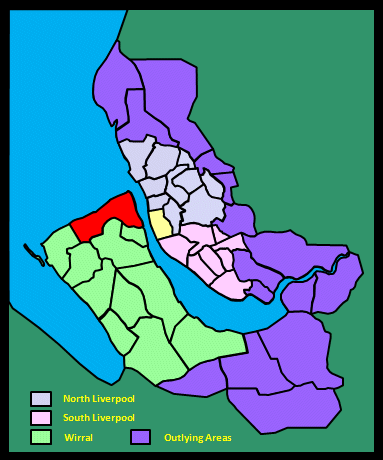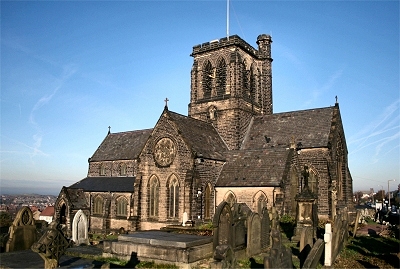 |
St.
Hilary's Church, Wallasey
St. Hilary's is the parish church of Wallasey. A notice
outside proclaims that there has been worship here for
1400 years and the present church is believed to be the
sixth on the site. There was probably a timber Saxon
church before the year 902, when the Vikings named the
hamlet Kirkeby in Walea meaning 'the village
with the church on the island of the Britons'. The
reference to an island presumably refers to the time when
this area was cut off by Wallasey Pool and marshland that
reached across to the sea at Leasowe. Several stones have
been found of a Norman structure, thought to date from
1162-1182, on the site. This was rebuilt and a tower
added during the reigns of Edward I and Edward II. The
next rebuilding was in the 16th century, when the tower
was reconstructed in 1530. In 1757, the church was in
ruins and was rebuilt. This fifth church burnt down in
1857, but the tower still stands alone in the churchyard.
The present one was completed in 1859, using stone
donated by a local quarry, in a style felt to be in
keeping with the new wealth and status of the rapidly
expanding Liverpool and Merseyside port and economy. It
contains a lot of fine 19th and 20th century stained
glass.There are only eight churches in Britain named
after the French Bishop of Poitiers, St. Hilary. It is
likely that these churches were founded by another French
Bishop, St Germanus, who came from near Poitiers and who
was invited as a missionary by the 5th century English
church. |
|
Wallasey in Lewis's
Topographical Dictionary of England (1848)
This parish, situated in the north-west corner of the
county, is a peninsula of triangular form, bounded on the
west by the Irish Sea, on the north-east by the Mersey,
and on the south-east by a branch of the Mersey, called
Wallasey Pool or the new Birkenhead Float. Bordering on
the sea are sand-hills, forming a natural barrier against
its encroachments. Many handsome houses and marine villas
have been erected on the banks of the Mersey, and the
villages near the river are much frequented for bathing.
An act was passed in 1845 for paving, lighting, and
otherwise improving the parish, and for establishing a
market. By the sea side is an ancient mansion denominated
Mockbeggar Hall, or more properly, Leasowe Castle,
formerly a seat of the Egertons. The building originally
consisted only of an octagonal tower, with square turrets
on the alternate faces; in 1818 great additions were made
to it, and many alterations since, so that the castle is
now of considerable extent. It is a decorative stone
structure containing several handsome apartments, among
which is one fitted up with the oak panelling that
covered the walls of the celebrated Star Chamber at
Westminster, and which was purchased on the demolition of
the old Exchequer Buildings, in 1836. Between the village
and the shore is the inclosure (formerly a common) named
the Leasowe, where races, of very early origin, were held
till 1760; here the unfortunate Duke of Monmouth ran his
horse, in the reign of Charles II., won the plate, and
presented it to the daughter of the mayor of Chester.
[...] The general surface is flat, and there are some
quarries of sandstone. [...] The church, rebuilt about 90
years since, except the tower, which bears date 1530,
stands in the centre of the parish, on a hill composed of
red-sandstone: it was enlarged in 1837. There were two
other churches prior to the Dissolution, appropriated to
Birkenhead Abbey, but no traces exist of them, though a
path is still called the Kirkway. |
Wallasey in The
Beauties of England and Wales, Vol II, Edward Wedlake
Brayley and John Britton (1809)
Wallisea is a spacious but deserted mansion, standing
near the village of the same name, at the northern corner
of the Wirral Hundred. [...] Between one and two miles
from Wallisea, a very noble hotel was erected, about ten
years ago, by Sir John Thomas Stanley, Bart. of Alderley,
for the accommodation of persons visiting the sea side.
This is much frequented in the summer season by the
resident families of Cheshire and its neighbourhood, who
visit this spot for the purpose of bathing in Hyle Lake,
which is bounded by the projecting land of the Wirral
peninsula, and the coast of the small Isle of Hilbree, or
Hillebyri. The Isle is about one mile in circuit, and
though the soil is scarcely anything but sand, had
formerly a cell of Benedictine monks, belonging to the
abbey at Chester. [Hyle Lake] was named Wallase Lezer, a
large fine spot, where races were run for many years; but
those races are now run at Newmarket, though still called
the Wallisea stakes. |
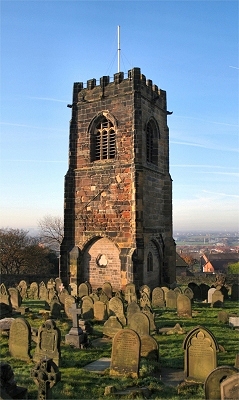 |
The
Old Tower, St. Hilary's Church, Wallasey
This 1530 tower was left standing after a disastrous fire
in 1857. |
|
St. Hilary's fire in the Liverpool
Daily Post on the 2nd February 1857
The Parish Church of Wallasey, an ancient edifice, was
utterly destroyed by fire yesterday forenoon. [...] It
appears that yesterday morning, so early as 2 o'clock, an
inhabitant of the village, on looking through his bedroom
window, discovered smoke and flame issuing from the
church, and immediately communicated the fact to the
rector, the Rev P Haggit. The Rector and several of the
parishioners proceeded at once to the spot, and found
that the flames were breaking through the windows, and
the fire presented an alarming aspect. A messenger was
dispatched for the Birkenhead Fire Brigade [...]. In the
meantime the flames spread rapidly, the persons present
being unable to do anything towards arresting their
progress. From every window the fire burst forth, and
burnt with such brilliancy as to be visible from a
distance of several miles. In a brief period the roof
fell in, shortly afterwards the fire brigade from
Birkenhead arrived at half past three, but even then any
efforts they could make were inoperative from the want of
a supply of water. [...]. The body of the church was
completely gutted and presented nothing but a heap of
smouldering ruins. [...] The organ created a few years
ago, and which cost three hundred guineas, was totally
consumed, also a handsome font, presented to the church
by Mr Chambers. The church contained a set of six bells,
which fell with a tremendous crash during the progress of
the fire. Only two of the bells remain entire, the
remainder being broken to pieces. The church underwent
very extensive improvements a year or two ago, and a
large sum of money was expended. A new roof was added,
and the organ and the font previously alluded to were
introduced at the same time. As to the origin of the fire
there is little doubt. The fires connected with the flues
for heating the building were lighted as usual about
eight on Saturday evening, and it is supposed that some
of the flues, becoming overheated, had ignited the
flooring, and thus led to the fatal results which
followed. [...]. The church was one of the oldest
ecclesiastical edifices in the neighbourhood. The tower
bears the date of 1530, although the church itself was
rebuilt about 100 years ago. The ruins constitute an
interesting sight, and during the whole of yesterday
crowds went to view the desolation. |
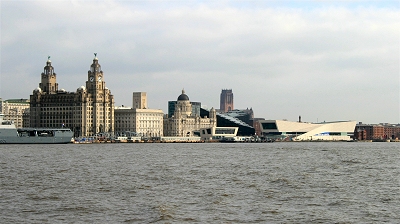 |
The
Liverpool Waterfront from Seacombe
Seacome was
Poulton-cum-Seacombe in earlier times, the places now
separated. |
 |
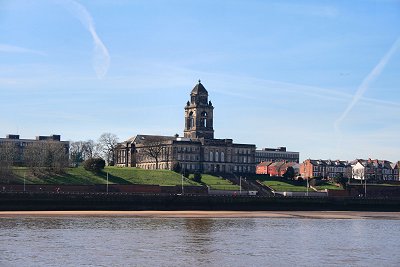 |
Wallasey
Town Hall
The rather grand Wallasey Town Hall is a prominent
landmark overlooking the river, which is its best
viewpoint. It was completed
in 1920. |
 |
Seacombe in Lewis's
Topographical Dictionary of England (1848)
This township is bounded on the east by the river Mersey,
on the north by Liscard, and on the south by Wallasey
Pool; and comprises [..] mostly arable and pasture land,
and chiefly of a clay soil. Being situated opposite to
Liverpool (to which a steam-boat plies every half hour),
there is a fine view of that town and its vicinity; while
in another direction are seen the Cheshire hills and the
Welsh mountains. The village is situated on Wallasey
Pool, and overlooks Oxton hill, Birkenhead, &c.; it
is remarkable for the salubrity of its air. Much land has
been reclaimed in the township, by the Birkenhead Dock
Commissioners. Here are very extensive works of various
kinds. [...] At the eastern extremity of the township is
the station of the ancient ferry, with a large hotel. The
ferry [...] has a good supply of steam-boats; and the
hotel is furnished with a bowling-green, a billiard-room,
and every accommodation. The rapid tide occasioned by the
inlet of Wallasey Pool, rendered the landing inconvenient
until the erection of a stage, of a very uncommon
construction, worked by means of a moveable steam-engine,
upon a tramway. To the south of the ferry, a row of
pleasant houses now faces the Mersey, and the shore is
crested with elegant residences. [...] Poolton [Poulton]
village, which lies a mile up Wallasey Pool, from its
situation in a small cove bordered with flourishing
trees, and the rural simplicity of its houses, forms a
pleasing contrast to the activity and bustle prevailing
at the ferry. [...] Magnetic sand [...] is to be seen
along the coast from Seacombe Point to the Rock
lighthouse, oozing from under the bed of clay, and
streaking the shores with black: the magnetic sand is
easily attracted by the magnet. |
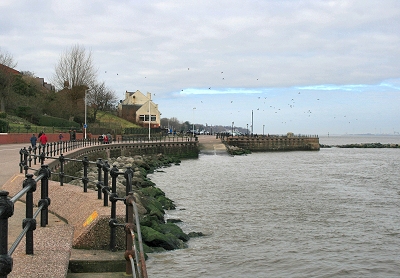 |
Egremont
Quay |
 |
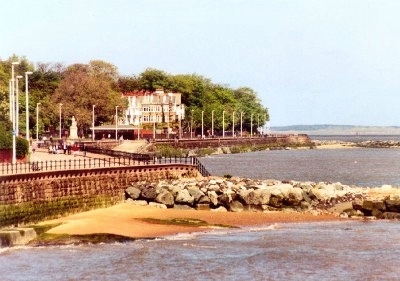 |
Egremont
Promenade
Torquay? Not quite, but the view from the Egremont Ferry
quay goes some way to explaining the popularity of
excursions to this side of the Mersey for more than 100
years. There have been no ferry services here since 1941,
but the ferry ride to Seacombe followed by the walk to
New Brighton is still the essential day out for scousers.
Note how clean the sand is. When I was a kid, the tide
washed up unspeakable things around here. Thankfully
things aren't always what they used to be! |
 |
Mother Redcap in Recollections
of Old Liverpool (1863), an
anonymous author recalling the mid-18th century
Near Egremont, on the shore, there used to be a little
low public house, known as Mother Redcap's, from the fact
of the owner always wearing a red hood or cap. This
public house is still standing. I have often been in it.
[...] Mother Redcap was a great favourite with the
sailor-men and had their entire confidence. She had
hiding places for any number, and the men used, on
returning from their voyages, to deposit with her their
pay and prize money, until they wanted it. It was known,
or at least, very commonly believed, that Mother Redcap
had in her possession enormous (for her) sums of money,
hidden or put away somewhere, but where that somewhere
was, it was never known; for, at her death, very little
property was found in her possession, although only a few
days before she was taken ill and died, a rich prize was
brought into Liverpool which yielded every sailor on
board at least a thousand pounds. Mother Redcap's was
swarming with sailors belonging to the privateer,
directly after the vessel had come into port, and it was
known that the old lady had received a good deal of the
prize money on their account, yet none of it was ever
discovered. It is a very remarkable circumstance that
some few years ago, I think about ten or twelve, but I
forget exactly when, a quantity of money in spade-ace
guineas was found in a cavity by the shore, not far from
Mother Redcap's. It has always been a firm belief with me
that some day a rich harvest will be in store for
somebody. |
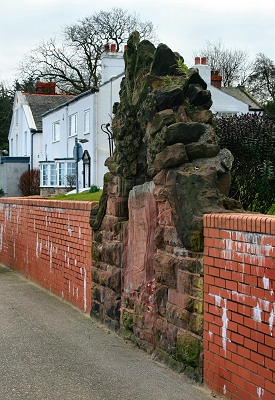 |
Mother
Redcap's Memorial, Egremont |
 |
Liscard in Lewis's
Topographical Dictionary of England (1848)
Some years ago this township presented an almost barren
waste, large heaps of sand lying in many parts, and there
being only a village, with a few small hovels the abode
of fishermen, and a range of low cottages used for a
magazine. An extensive and rapid change has, however,
been effected; several settlements have been made, and
labour and enterprise have succeeded in fertilizing and
enriching a district for which nature seemed to have done
so little. The shore for a great distance is now studded
with elegant houses, and even among the sand-hills many
spots have been chosen for villas, which are the
residences of opulent families from Liverpool. New
Brighton, in the township, has sprung up since 1830. In
that year the late James Atherton, Esq., conceived the
design of founding a watering-place at the north-east
angle of the township, and in furtherance of his plan
purchased 180 acres of ground in that quarter, where the
convex form of the coast, presenting one front to the
Mersey and another to the open sea, appeared well adapted
to the purposes of a marine village. Here streets fifteen
yards in width, and nearly a mile in extent, now ascend
from both shores, and intersect each other at right
angles; the whole being laid out on a regular and
symmetrical plan, with a pier having the requisite
landing-stages, an hotel and other accommodation for
visiters, hot and cold baths, &c., and, in short,
every convenience for either permanent or temporary
residence. The erection of buildings continues on every
side, many of them being highly ornamental and elegant;
and the village promises to be, at no distant day, one of
the most fashionable watering-places in this part of the
kingdom. The hamlet of Egremont is also in the township,
and on the Mersey, nearly opposite to Liverpool, from
which it is distant one mile and a half; it contains
several handsome dwellings, hotels, and lodging-houses,
and is likewise a favourite and genteel bathing-place.
Near this hamlet is the magazine where all ships entering
the port of Liverpool deposit their gunpowder, prior to
admission into the docks. Steam-boats ply every half hour
from New Brighton and Egremont to Liverpool. |
 |
Mariner's
Cottage, New Brighton
The old part of New Brighton is charming and peaceful,
though compact. There are several old properties such as
these. |
 |
New Brighton in Lewis's
Topographical Dictionary of England (1848)
A bathing-place [...]. It forms the north-east corner of
the peninsula of Wirrall, being bounded by the river
Mersey on the east, and on the north by the Irish Sea;
and comprises 180 acres, of undulated surface, and hilly
in some parts, the whole laid out in roads, and studded
with mansions, many of them of much architectural beauty.
The striking features of the locality have been taken
advantage of in constructing a series of marine villas,
which, rising one above another, have a most picturesque
effect as seen from a distance. Spacious streets, fifteen
yards wide, have been formed: several excellent hotels
and boarding-houses have been built; and the
accommodation which the place affords, the salubrity of
its air, and the convenience of bathing, have made it the
residence of eminent merchants, and the resort of
visiters generally of the wealthy classes. The sandy
beach is very smooth, dry, and firm; and the water on the
shore, beautifully pellucid. From the higher grounds are
extensive views of the Welsh mountains, the opposite port
of Liverpool, and the shipping on the Mersey. A reservoir
has been constructed for supplying the inhabitants with
water, and on the shore is a spring of fine fresh water,
which, though covered over by the tide, is perfectly pure
when the sea retires. Upon the Black rock, where the
Mersey enters the Irish Channel, is a very strong fort,
mounting fifteen large guns, and approached from the main
land by a drawbridge; and further off the shore is a
small lighthouse, on the plan of the Eddystone, built of
Anglesey marble at a cost of £34,500, defrayed by the
corporation of Liverpool: it rises ninety feet, and is
completely surrounded at high tides, like the fort, by
the water. Steamers run to and from Liverpool every hour.
A site and £500 have been offered for building a church,
and plans are in progress for its erection. The masses of
sandstone near the Black rock, called the Red and Yellow
Noses, well merit the attention of the naturalist, being
worn by the action of the sea into a variety of caverns
of the most romantic forms; a tunnel has been cut through
one of them from the beach, forming a private entrance up
to Cliffe Villa. |
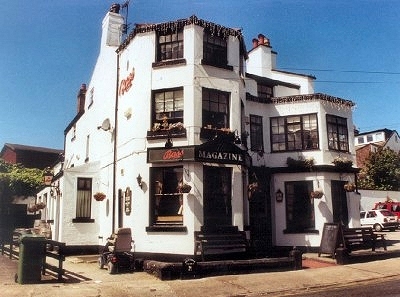 |
The
Magazine Pub, New Brighton
A great little pub on Magazine Brow in the old part of
New Brighton set just back from the river near Vale Park.
You can sit in front and look out over the river - very
pleasant. |
 |
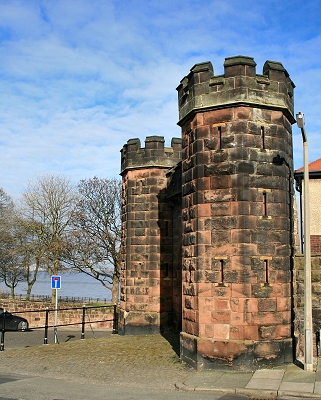 |
The
Magazine, New Brighton
The magazine, in the old part of New Brighton, was used
for the storage of gunpowder. It was located well away
from the nearest docks in case of explosion (presumably
when this was a more rural area). The explosion of the
gunpowder ship Lotty Sleigh on the River Mersey in 1864,
which caused devastation over a three mile radius, showed
what could happen given a chance. |
 |
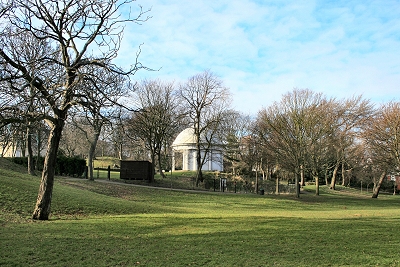 |
Vale
Park, New Brighton |
 |
New Brighton in Recollections
of Old Liverpool (1863), an
anonymous author recalling the mid-18th century
There were no houses then anywhere about what is now
called New Brighton. The country was sandy and barren,
and the only trees that existed grew close to the mouth
of the river near the shore. There was scarcely a house
between the Rock and Wallasey. Wirral was a desperate
region. The inhabitants were nearly all wreckers or
smugglers - they ostensibly carried on the trade and
calling of fishermen, farm labourers, and small farmers,
but they were deeply saturated with the sin of
covetousness, and many a fierce fire has been lighted on
the Wirral shore on stormy nights to lure the good ship
on the Burbo or Hoyle Banks, there to beat, and strain,
and throb, until her timbers parted, and her planks were
floating in confusion on the stormy waves. Fine times,
then, for the Cheshire men. On stormy days and nights,
crowds might have been seen hurrying to the shore with
carts, barrows, horses, asses, and oxen even, which were
made to draw timber, bales, boxes, or anything that the
raging waters might have cast up. Many a half-drowned
sailor has had a knock on the sconce whilst trying to
obtain a footing, that has sent him reeling back into the
seething water, and many a house has been suddenly
replenished with eatables and drinkables, and furniture
and garniture, where previously bare walls and wretched
accommodation only were visible. Then for smuggling fine
times the runners used to have in my young days. Scarcely
a house in north Wirral that could not provide a guest
with a good stiff glass of brandy or Hollands. The
fishermen used to pretend to cast their nets to take the
fish that then abounded on our coasts, but their fishing
was of a far different sort. |
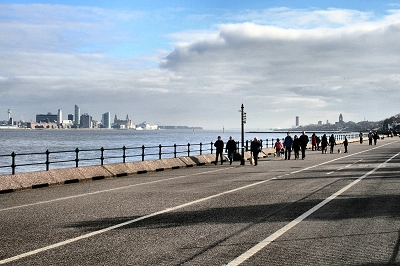 |
Promenaders
at New Brighton |
 |
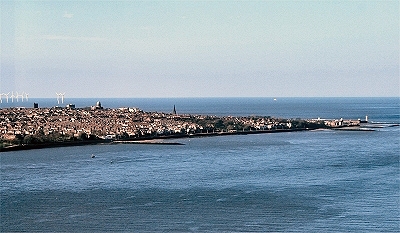 |
New
Brighton from Liverpool's West Tower |
|
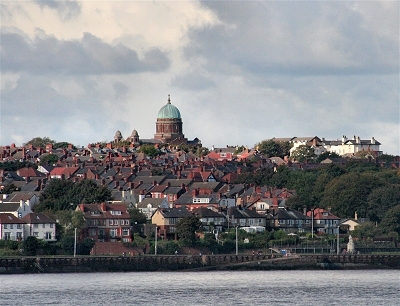 |
New
Brighton with the Church of St. Peter and St. Paul
St. Peter and St. Paul's catholic church is a dominant
landmark on the left bank of the Mersey Estuary. Its
green dome has earned it the nickname The Dome of
Home from returning sailors. It was opened in 1935
and its future is uncertain at the moment. |
|
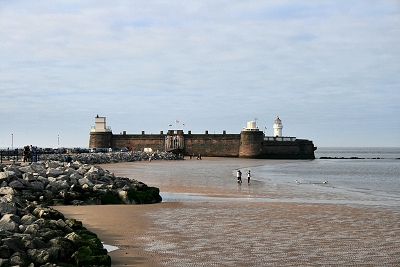 |
Fort
Perch Rock and the Lighthouse, New Brighton
This Napoleonic defensive structure was finally completed
in 1829, after Napoleon's death, and was nicknamed the
Little Gibraltar of the Mersey. There were originally 18
guns and accomodation for 100 men. It was finally
decommissioned and sold in 1954. After a rocky period (no
pun intended), it is now restored and houses a museum. |
|
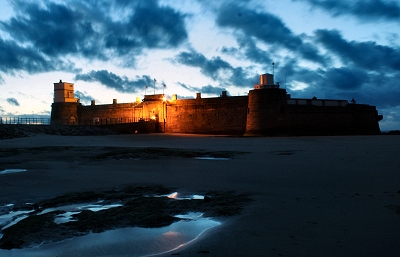 |
Fort
Perch Rock, New Brighton
My thanks to Dave Steel for this photo. |
 |
Wallasey Caves in Recollections
of Old Liverpool (1863), an
anonymous author recalling the mid-18th century
I have been up the tunnels or caves at the Red and White
Noses [rocky outcrops on the Wallasey coast] many a time
for great distances. I was once fishing for codling at
the Perch, and with two young companions went up the
caves for at least a mile, and could have gone further
only we became frightened as our lights went out. It was
thought these caves ran up to Chester Cathedral, but that
was all stuff. I believe they were excavated by smugglers
in part, and partly natural cavities of the earth. We
knew little then of archaeology or geology, or any other
"ology", or I might be able to tell a good deal
about these caves, for I saw them more than once, but I
now forget what their size and height was. The floor, I
recollect, was very uneven and strewed about with big
stones, while the roof was arched over in the red
sand-stone. The encroachment of the sea upon the Wirral
shore has been very gradual, but regular, for many years.
Within the memory of man the sea has made an inroad of
nearly, if not quite, a mile from its former high water
mark. It was not until the erection of the Wallasey
embankment that a stop was put to its ravages. |
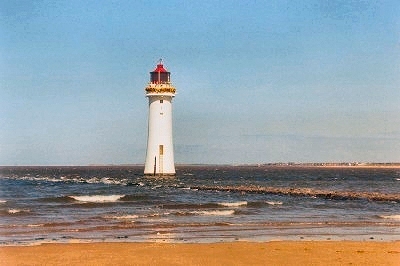 |
The
Rock Lighthouse, New Brighton
The Rock Lighthouse, or Perch Rock
Lighthouse, next to Fort Perch Rock, marks the
extreme northern tip of the Wirral. The first structure
here, erected in 1683, was a large wooden tripod or perch
bholding a fire, hence the current name (formerly Black
Rock). This was regularly destroyed by shipping and
acquired a light in the early 19th century. Nevertheless
it was demolished again in 1821 when a Mersey pilot boat
collided with it during a storm. The present lighthouse
is 93 ft (28 m) high and of very solid construction,
costing £27,500 by the time it was completed in 1830. It
had possibly the first revolving light in the country. It
was decommissioned in 1973 when its role was superceded
by the radar system at Crosby. |
 |
The entrance to the Mersey in Lewis's
Topographical Dictionary of England (1848)
At the entrance of the river is the Black Rock
lighthouse, erected on a point of rock on the western
coast, which is covered at quarter flood, and above the
surface of which the water at high spring tides rises 20
feet. This lighthouse was built at the expense of the
corporation, from a design by the late Mr. John Foster,
at an expense of £34,500, and was assigned to the Dock
estate at a nominal rent: the structure is of limestone
brought from Beaumaris, and was completed, and the light
first exhibited, on the 1st of March, 1830; it is
triangular, and presents successively two lights of a
natural colour, and one of brilliant red, every minute.
Floating lights, also, have been placed eleven miles
seaward from the mouth of the river Mersey, by the
committee for the management of the docks; and
pilot-boats stationed there are constantly on the
look-out. A new channel called the Victoria Channel, near
Formby Point, was opened by dredging in 1835; and at
Crosby Point is a lighthouse which, in conjunction with a
light-vessel moored in the Crosby Channel, renders the
port easy of access at all times of the tide either by
day or night. [...] A telegraph is established, by means
of which, communications have been interchanged between
this town and Holyhead, distant 72 miles, in the space of
a minute. |
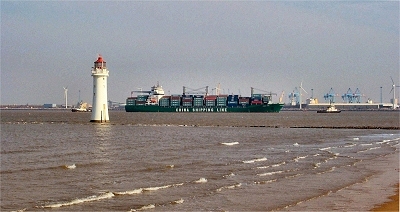 |
Entrance
to the Mersey at New Brighton
A large container ship is being manoeuvered by tugs into
the container port at Seaforth on the other side of the
Mersey estuary. It is hard to imagine now, but there is
strong reason to believe that the opening to the sea here
did not exist until some time between the departure of
the Romans (ca. 410 AD) and the Norman Conquest (1066).
This would account for the complete obscurity of
Liverpool until the 11th century. The Romans left no
mention of a usable estuary here (or roads to it),
although those of the Dee to the south and the Ribble to
the north were of prime importance to them, as witnessed
by the significant remains they left behind. The outlet
of the river Mersey is presumed to have been through
Wallasey Pool (Birkenhead Docks), Bidston Moss and
perhaps along the line of the River Birket, reaching the
sea at Leasowe Common near the lighthouse. There appears
to have been a powerful earthquake in the fifth century,
which may have been responsible for the new opening.
There is a tradition that there was during the Dark Ages
a bridge over the Mersey, then just a stream, between two
large forested areas. There is much evidence of the
latter on the local shores (particulary at Hightown,
q.v.) and buried under the south-west Lancashire Mosses. |
 |
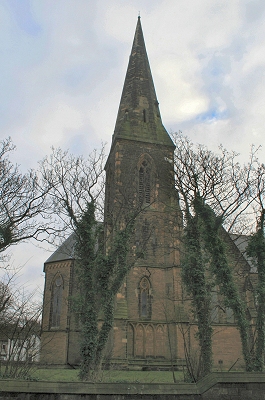 |
St.
James's Church, New Brighton
St. James's Church is the work of George Gilbert Scott
and was completed in 1856. |
|
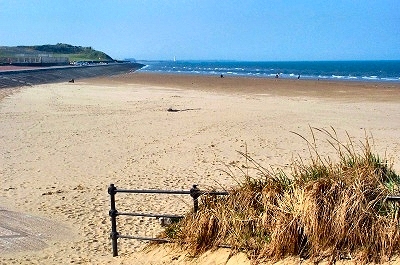 |
Beach
near New Brighton
Local tradition has it that this part of the coast was
where King Canute had his famous altercation with the
waves. On the sea-front near Leasowe Castle, there was
once a so-called Canute Chair with the
inscription 'Sea come not hither nor wet the sole of my
foot'. |
 |
 |
The
North Wirral Coast from New Brighton to Leasowe
This area of the Wirral coast was once the haunt of a
notorious community of wreckers. Following the wreck here
at Christmas 1838 of the packet ship 'Pennsylvania' en
route from Liverpool to New York during a hurricane-force
storm, a Liverpool newspaper commented, 'We lament to
find that these infamous wretches, the wreckers, have
been at their fiendlike occupation, plundering what the
elements have spared, instead of seeking to alleviate the
calamities of their fellow creatures. The wreckers who
infest the Cheshire coast were not long in rendering the
catastrophe a source of emolument to themselves. The
property of the passengers and crew where plundered by
them to an alarming extent.' Another writer in 1863
noted, 'Wirral at that time [...] was a desperate region,
the inhabitants were nearly all wreckers and smugglers,
they ostensibly carried on the trade and calling of
fishermen, farm labourers and small farmers, but they
were deeply saturated with the sin of covetousness, and
many a fierce fire has been lighted on the Wirral shore
on stormy nights to lure the good ship on the Burbo or
Hoyle banks, there to beat and strain and throb until her
timbers parted and her planks were floating in confusion
on the stormy waves. Fine times then for the Cheshire
men. On stormy days and nights, crowds might have been
seen hurrying to the shore with carts, barrows, horses,
asses, or oxen even which were made to draw timber,
bales, boxes or anything that the raging waters might
have cast up. Many a half-drowned sailor has had a knock
on the sconce, whilst trying to obtain a footing that has
sent him reeling back into the seething water, and many a
house had been suddenly replenished with eatables and
drinkables and furniture and garniture where previously
bare walls and wretched accommodation only were visible.' |
 |
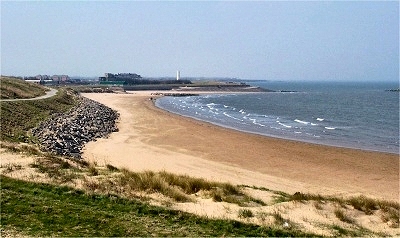 |
Leasowe
Shore
This stretch of coast around Leasowe and Meols lies
within the North Wirral Coastal Park, one of the
country's top sites for wildlife and a Site of Special
Scientific Interest. Wading birds, particularly
Oystercatcher, Redshank, Dunlin, Sanderling, Turnstone,
Lapwing, Bar-tailed Godwit and Curlew visit during the
winter or migrate through in autumn and spring. Inland
are rare plants and a very rare British sub-species of
the Belted Beauty Moth, one of only two known sites in
the world. The area was inhabited in stone-age times and
remains of their habitations have been found on the
beach. It remained important in Roman and Viking times. |
 |
 |
Leasowe
Lighthouse
The first Leasowe Lighthouse (originally known as the Mockbeggar
Light) was built in 1763 by the Liverpool
Corporation Docks Committee. It was one of two, the other
of which was a short distance off-shore and was washed
away in a storm in 1769. Taking a sight on both
lighthouses was intended to aid entry to the Mersey
estuary. This function was restored by a new lighthouse
on Bidston Hill in 1771. Two further lighthouses were
constructed at Hoylake, then a major fishing port (the
four Leading Lights). The present lighthouse was
built in 1824 (the datestone is from the earlier one),
the oldest brick built lighthouse in Britain, and was in
operation until 1908. It is 101 ft (27 m) high and on 7
floors, accessed by a cast iron staircase and with
accomodation inside. The light was housed unusually in a
brick room with small rectangular windows. There used to
be an adjoining keeper's cottage, but this was demolished
when the lighthouse was decommisioned in 1908. The last
keeper was a Mrs. Williams, who moved into a cottage when
it ceased to function and kept the lighthouse as a
popular teahouse in the summer. Wallasey Corporation
acquired it in 1930. It was refurbished in 1989 by the Friends
of Leasowe Lighthouse, who host guided tours, and
houses a visitor centre on the ground floor. |
 |
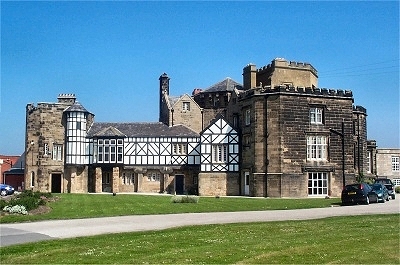 |
Leasowe
Castle
The original castle (the 'New Hall'), consisting of just
the octagonal tower, was built in 1593 by Ferdinando, the
5th Earl of Derby (of the Stanley family) and
subsequently Mayor of Liverpool. It is often said to have
been built as a viewing platform for the Wallasey horse
races that took place on the nearby sands, but is more
likely to have been simply a fortified home built in
uncertain times. The Stanleys had apparently abandoned it
within 100 years and it rapidly became a ruin. It became
known as Mockbeggar Hall (a common epithet for ruined
manorial halls) and the shore near here is still known
Mockbeggar Wharf. It was restored and extended during the
19th century and, after further periods of dereliction,
is now a hotel. |
 |
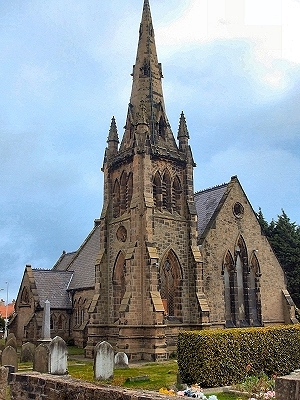 |
Christ
Church, Moreton
Christ Church dates from 1863. |
|
